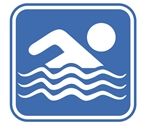The purpose of this activity is to engage students in using multiplicative and/or additive strategies to solve a measurement problem.
This activity assumes the students have experience in the following areas:
- Measuring length with metric units.
- Calculating with speed in kilometres per hour.
- Finding factors for given whole numbers.
The problem is sufficiently open ended to allow the students freedom of choice in their approach. It may be scaffolded with guidance that leads to a solution, and/or the students might be given the opportunity to solve the problem independently.
The example responses at the end of the resource give an indication of the kind of response to expect from students who approach the problem in particular ways.

A long distance swimmer takes 80 strokes to swim 100 metres. He wants to swim across Lake Taupō, a distance of 4 200 metres.
- How many strokes will it take for him to swim across the lake?
- If he can swim at a rate of 60 strokes per minute, how many minutes could he swim across the lake in?
- Can he expect to beat the 2015 champion swimmer who crossed the lake in a time of 51 minutes and 48 seconds?
The following prompts illustrate how this activity can be structured around the phases of the Mathematics Investigation Cycle.
Make sense
Introduce the problem. Allow students time to read it and discuss in pairs or small groups.
- Do I understand the situation and the words? (Students may need support to understand the context if they are not familiar with long distance swimming. Words like ‘strokes’, and ‘rate’ will need to be understood.)
- What are the important measurements in the problem? (4200 metres is equal to 4.2 kilometres. 60 strokes per minute is equal to one stroke per second.)
- What maths will I need to know and use? (Students need to recognise the use of rates in the situation, such as 60 strokes per minute.)
- What will my solution look like? (The solution will the number of strokes and associated time the swimmer will take, a comparison of that time to the record, and supporting calculations that validate the answers.)
Plan approach
Discuss ideas about how to solve the problem. Emphasise that, in the planning phase, you want students to say how they would solve the problem, not to actually solve it.
- What strategies can I use to get started? (A ratio table might be useful)
- Could I make the numbers simpler to get an idea of how to solve the problem?
- What tools (digital or physical) could help my investigation? (Calculators may ease the burden of calculation for some students.)
- How will I record my workings so they can be checked and shown to others?
- Will I need help from others to solve this problem? How will the other people help me?
- Do I have a sense of the answer before I start? What time seems reasonable?
Take action
Allow students time to work through their strategy and find a solution to the problem.
- Am I recording my workings in a clear, step-by-step way?
- Is my strategy working or do I need to try something else?
- Does my answer seem correct? Is it close to my estimation?
- How could I make sure that I haven’t missed anything?
- Are there any patterns?
- How might I describe the patterns?
- Does my solution meet the requirements? Does it answer the question?
- Is there another possible way to solve it?
Convince yourself and others
Allow students time to check their answers and then either have them pair share with other groups or ask for volunteers to share their solution with the class.
- What is my solution? How does it compare to my estimate?
- Is my working clear for someone else to follow?
- How have others solved the problem?
- Could I have solved the problem in a more efficient way?
- Which ideas would convince others that my findings answer the investigation question?
- What might I try next time I have a similar problem?
- Is there some mathematics that I need to learn?
Examples of work
Work Sample 1
The student calculates with rates using multiplication and division, particularly applying the distributive property. They correctly calculate the number of strokes needed, and how much time the swim will take.
Click on the image to enlarge it. Click again to close.
Work Sample 2
The student calculates with rates using multiplication and division, particularly applying the distributive property. They correctly calculate the number of strokes needed, and how much time the swim will take. Finally, they compare the swimmers time to the current record.

